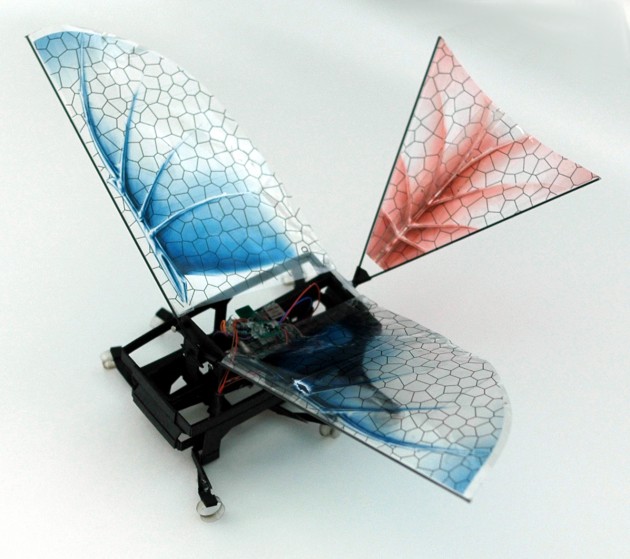When engineers at the University of California, Berkeley, outfitted a six-legged robotic bug with wings in an effort to improve its mobility, they unexpectedly shed some light on the evolution of flight.
Adding wings to a robotic bug helped it run faster and better, but was it enough to achieve takeoff?
Even though the wings significantly improved the running performance of the 10-centimeter-long robot – called DASH, short for Dynamic Autonomous Sprawled Hexapod – they found that the extra boost would not have generated enough speed to launch the critter from the ground. The wing flapping also enhanced the aerial performance of the robot, consistent with the hypothesis that flight originated in gliding tree-dwellers.
The research team, led by Ron Fearing, professor of electrical engineering and head of the Biomimetic Millisystems Lab at U.C. Berkeley, reports its conclusions online Tuesday, Oct. 18, in the journal Bioinspiration and Biomimetics.
Using robot models could play a useful role in studying the origins of flight, particularly since fossil evidence is so limited, the researchers noted.
First unveiled by Fearing and graduate student Paul Birkmeyer in 2009, DASH is a lightweight, speedy robot made of inexpensive, off-the-shelf materials, including compliant fiber board with legs driven by a battery-powered motor. Its small size makes it a candidate for deployment in areas too cramped or dangerous for humans to enter, such as collapsed buildings.

DASH+Wings showed the possibility of using robotic models to provide insight into biological performance. (Image by Kevin Peterson, Biomimetic Millisystems Lab)
A robot gets its wings
But compared with its biological inspiration, the cockroach, DASH had certain limitations as to where it could scamper. Remaining stable while going over obstacles is fairly tricky for small robots, so the researchers affixed DASH with lateral and tail wings borrowed from a store-bought toy to see if that would help.
The researchers ran tests on four different configurations of the robotic roach, now called DASH+Wings. The test robots included one with a tail only and another that just had the wing’s frames, to determine how the wings impacted locomotion.
With its motorized flapping wings, DASH+Wings’ running speed nearly doubled, going from from 0.68 meters per second with legs alone to 1.29 meters per second. The robot could also take on steeper hills, going from an incline angle of 5.6 degrees to 16.9 degrees.
“With wings, we saw improvements in performance almost immediately,” said study lead author Kevin Peterson, a Ph.D. student in Fearing’s lab. “Not only did the wings make the robot faster and better at steeper inclines, it could now keep itself upright when descending.”
The flapping wings improved the lift-drag ratio, helping DASH+Wings land on its feet instead of just plummeting uncontrolled. Once it hit the ground, the robot was able to continue on its way.
Tree-dwellers vs. ground-runners
The engineering team’s work caught the attention of animal flight expert Robert Dudley, a UC Berkeley professor of integrative biology and researcher at the Smithsonian’s Tropical Research Institute, who noted that the most dominant theories on flight evolution have been primarily derived from scant fossil records and theoretical modeling.
He referenced previous computer models suggesting that ground-dwellers, given the right conditions, would need only to triple their running speed in order to build up enough thrust for takeoff. The fact that DASH+Wings could maximally muster a doubling of its running speed suggests that wings do not provide enough of a boost to launch an animal from the ground. This finding is consistent with the theory that flight arose from animals that glided downwards from some height.
“The fossil evidence we do have suggests that the precursors to early birds had long feathers on all four limbs, and a long tail similarly endowed with a lot of feathers, which would mechanically be more beneficial for tree-dwelling gliders than for runners on the ground,” Dudley says.
The winged version of DASH is not a perfect model for proto-birds – it has six legs instead of two, and its wings use a sheet of plastic rather than feathers – and thus cannot provide a slam-dunk answer to the question of how flight evolved, Dudley explained.
“What the experiments did do was to demonstrate the feasibility of using robot models to test hypotheses of flight origins,” he said. “It’s the proof of concept that we can actually learn something useful about biological performance through systematic testing of a physical model.”
—Source: University of California, Berkeley





